tire type HUMMER H3 2009 Owners Manual
[x] Cancel search | Manufacturer: HUMMER, Model Year: 2009, Model line: H3, Model: HUMMER H3 2009Pages: 382, PDF Size: 1.99 MB
Page 194 of 382
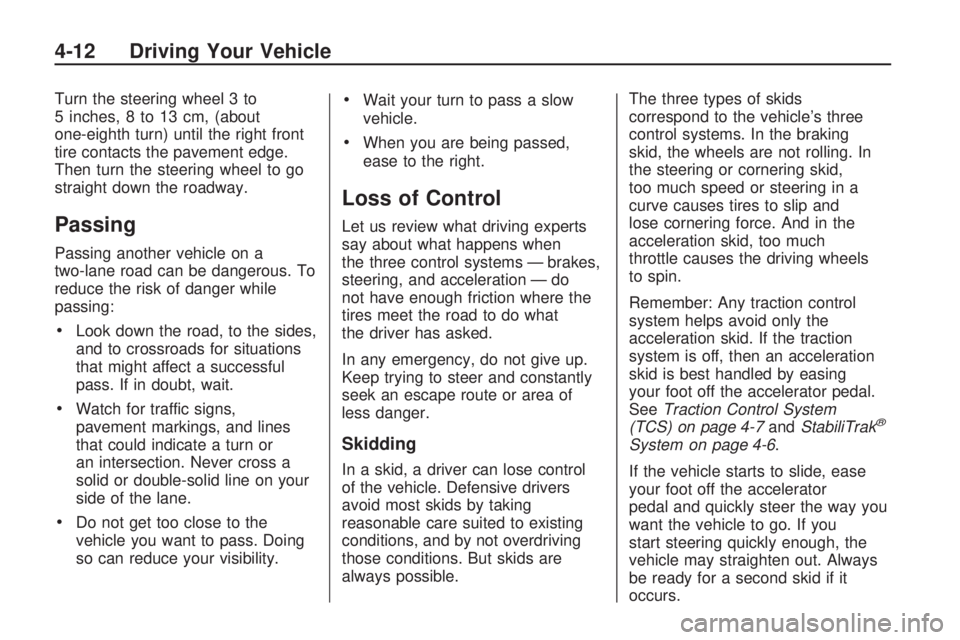
Turn the steering wheel 3 to
5 inches, 8 to 13 cm, (about
one-eighth turn) until the right front
tire contacts the pavement edge.
Then turn the steering wheel to go
straight down the roadway.
Passing
Passing another vehicle on a
two-lane road can be dangerous. To
reduce the risk of danger while
passing:
Look down the road, to the sides,
and to crossroads for situations
that might affect a successful
pass. If in doubt, wait.
Watch for traffic signs,
pavement markings, and lines
that could indicate a turn or
an intersection. Never cross a
solid or double-solid line on your
side of the lane.
Do not get too close to the
vehicle you want to pass. Doing
so can reduce your visibility.
Wait your turn to pass a slow
vehicle.
When you are being passed,
ease to the right.
Loss of Control
Let us review what driving experts
say about what happens when
the three control systems — brakes,
steering, and acceleration — do
not have enough friction where the
tires meet the road to do what
the driver has asked.
In any emergency, do not give up.
Keep trying to steer and constantly
seek an escape route or area of
less danger.
Skidding
In a skid, a driver can lose control
of the vehicle. Defensive drivers
avoid most skids by taking
reasonable care suited to existing
conditions, and by not overdriving
those conditions. But skids are
always possible.The three types of skids
correspond to the vehicle’s three
control systems. In the braking
skid, the wheels are not rolling. In
the steering or cornering skid,
too much speed or steering in a
curve causes tires to slip and
lose cornering force. And in the
acceleration skid, too much
throttle causes the driving wheels
to spin.
Remember: Any traction control
system helps avoid only the
acceleration skid. If the traction
system is off, then an acceleration
skid is best handled by easing
your foot off the accelerator pedal.
SeeTraction Control System
(TCS) on page 4-7andStabiliTrak
®
System on page 4-6.
If the vehicle starts to slide, ease
your foot off the accelerator
pedal and quickly steer the way you
want the vehicle to go. If you
start steering quickly enough, the
vehicle may straighten out. Always
be ready for a second skid if it
occurs.
4-12 Driving Your Vehicle
Page 211 of 382
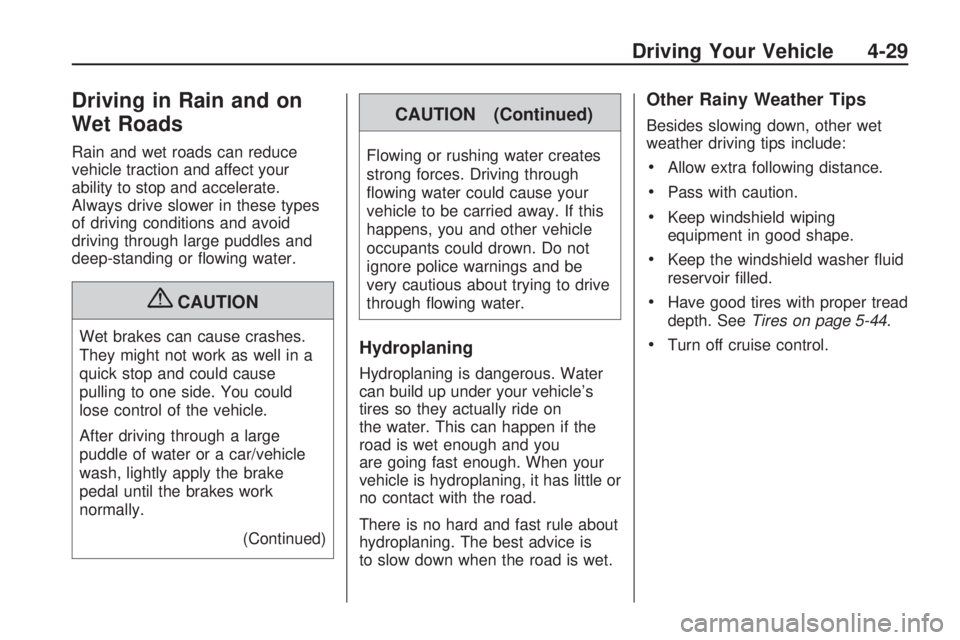
Driving in Rain and on
Wet Roads
Rain and wet roads can reduce
vehicle traction and affect your
ability to stop and accelerate.
Always drive slower in these types
of driving conditions and avoid
driving through large puddles and
deep-standing or �owing water.
{CAUTION
Wet brakes can cause crashes.
They might not work as well in a
quick stop and could cause
pulling to one side. You could
lose control of the vehicle.
After driving through a large
puddle of water or a car/vehicle
wash, lightly apply the brake
pedal until the brakes work
normally.
(Continued)
CAUTION (Continued)
Flowing or rushing water creates
strong forces. Driving through
�owing water could cause your
vehicle to be carried away. If this
happens, you and other vehicle
occupants could drown. Do not
ignore police warnings and be
very cautious about trying to drive
through �owing water.
Hydroplaning
Hydroplaning is dangerous. Water
can build up under your vehicle’s
tires so they actually ride on
the water. This can happen if the
road is wet enough and you
are going fast enough. When your
vehicle is hydroplaning, it has little or
no contact with the road.
There is no hard and fast rule about
hydroplaning. The best advice is
to slow down when the road is wet.
Other Rainy Weather Tips
Besides slowing down, other wet
weather driving tips include:
Allow extra following distance.
Pass with caution.
Keep windshield wiping
equipment in good shape.
Keep the windshield washer �uid
reservoir �lled.
Have good tires with proper tread
depth. SeeTires on page 5-44.
Turn off cruise control.
Driving Your Vehicle 4-29
Page 227 of 382
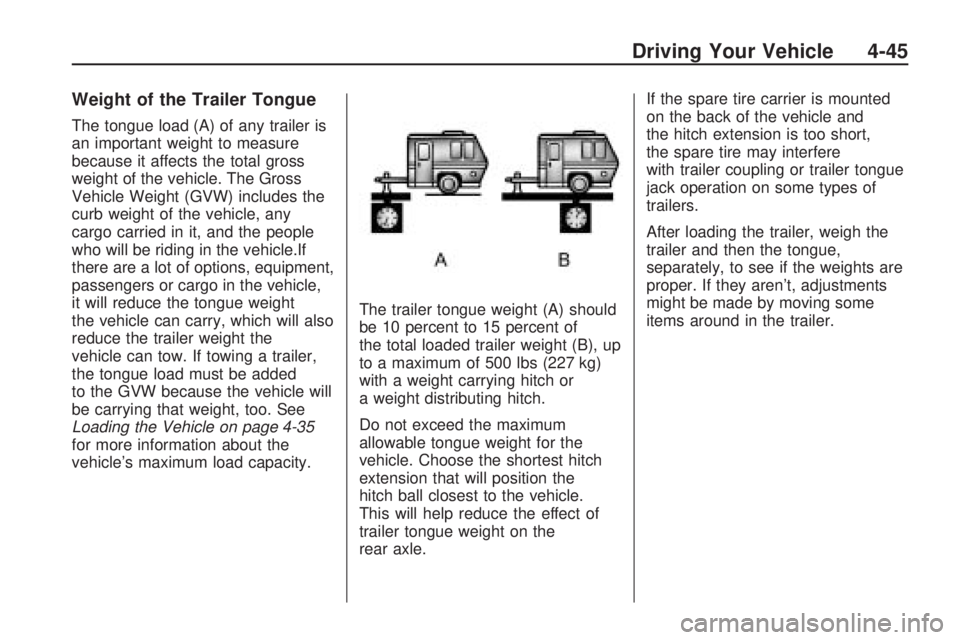
Weight of the Trailer Tongue
The tongue load (A) of any trailer is
an important weight to measure
because it affects the total gross
weight of the vehicle. The Gross
Vehicle Weight (GVW) includes the
curb weight of the vehicle, any
cargo carried in it, and the people
who will be riding in the vehicle.If
there are a lot of options, equipment,
passengers or cargo in the vehicle,
it will reduce the tongue weight
the vehicle can carry, which will also
reduce the trailer weight the
vehicle can tow. If towing a trailer,
the tongue load must be added
to the GVW because the vehicle will
be carrying that weight, too. See
Loading the Vehicle on page 4-35
for more information about the
vehicle’s maximum load capacity.The trailer tongue weight (A) should
be 10 percent to 15 percent of
the total loaded trailer weight (B), up
to a maximum of 500 lbs (227 kg)
with a weight carrying hitch or
a weight distributing hitch.
Do not exceed the maximum
allowable tongue weight for the
vehicle. Choose the shortest hitch
extension that will position the
hitch ball closest to the vehicle.
This will help reduce the effect of
trailer tongue weight on the
rear axle.If the spare tire carrier is mounted
on the back of the vehicle and
the hitch extension is too short,
the spare tire may interfere
with trailer coupling or trailer tongue
jack operation on some types of
trailers.
After loading the trailer, weigh the
trailer and then the tongue,
separately, to see if the weights are
proper. If they aren’t, adjustments
might be made by moving some
items around in the trailer.
Driving Your Vehicle 4-45
Page 280 of 382
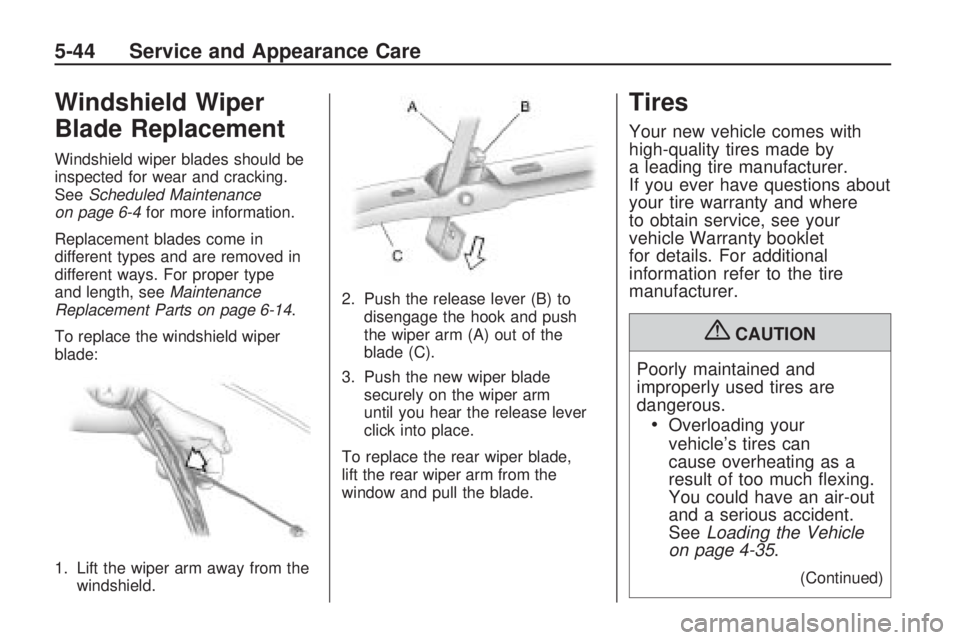
Windshield Wiper
Blade Replacement
Windshield wiper blades should be
inspected for wear and cracking.
SeeScheduled Maintenance
on page 6-4for more information.
Replacement blades come in
different types and are removed in
different ways. For proper type
and length, seeMaintenance
Replacement Parts on page 6-14.
To replace the windshield wiper
blade:
1. Lift the wiper arm away from the
windshield.2. Push the release lever (B) to
disengage the hook and push
the wiper arm (A) out of the
blade (C).
3. Push the new wiper blade
securely on the wiper arm
until you hear the release lever
click into place.
To replace the rear wiper blade,
lift the rear wiper arm from the
window and pull the blade.
Tires
Your new vehicle comes with
high-quality tires made by
a leading tire manufacturer.
If you ever have questions about
your tire warranty and where
to obtain service, see your
vehicle Warranty booklet
for details. For additional
information refer to the tire
manufacturer.
{CAUTION
Poorly maintained and
improperly used tires are
dangerous.
Overloading your
vehicle’s tires can
cause overheating as a
result of too much �exing.
You could have an air-out
and a serious accident.
SeeLoading the Vehicle
on page 4-35.
(Continued)
5-44 Service and Appearance Care
Page 281 of 382
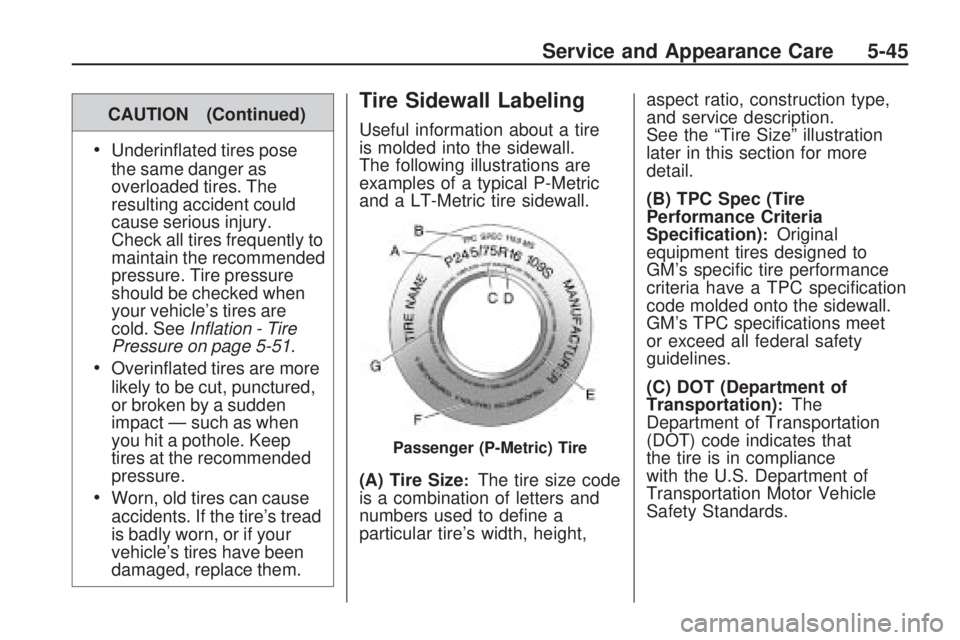
CAUTION (Continued)
Underin�ated tires pose
the same danger as
overloaded tires. The
resulting accident could
cause serious injury.
Check all tires frequently to
maintain the recommended
pressure. Tire pressure
should be checked when
your vehicle’s tires are
cold. SeeInflation - Tire
Pressure on page 5-51.
Overin�ated tires are more
likely to be cut, punctured,
or broken by a sudden
impact — such as when
you hit a pothole. Keep
tires at the recommended
pressure.
Worn, old tires can cause
accidents. If the tire’s tread
is badly worn, or if your
vehicle’s tires have been
damaged, replace them.
Tire Sidewall Labeling
Useful information about a tire
is molded into the sidewall.
The following illustrations are
examples of a typical P-Metric
and a LT-Metric tire sidewall.
(A) Tire Size
:The tire size code
is a combination of letters and
numbers used to de�ne a
particular tire’s width, height,aspect ratio, construction type,
and service description.
See the “Tire Size” illustration
later in this section for more
detail.
(B) TPC Spec (Tire
Performance Criteria
Speci�cation)
:Original
equipment tires designed to
GM’s speci�c tire performance
criteria have a TPC speci�cation
code molded onto the sidewall.
GM’s TPC speci�cations meet
or exceed all federal safety
guidelines.
(C) DOT (Department of
Transportation)
:The
Department of Transportation
(DOT) code indicates that
the tire is in compliance
with the U.S. Department of
Transportation Motor Vehicle
Safety Standards.
Passenger (P-Metric) Tire
Service and Appearance Care 5-45
Page 282 of 382
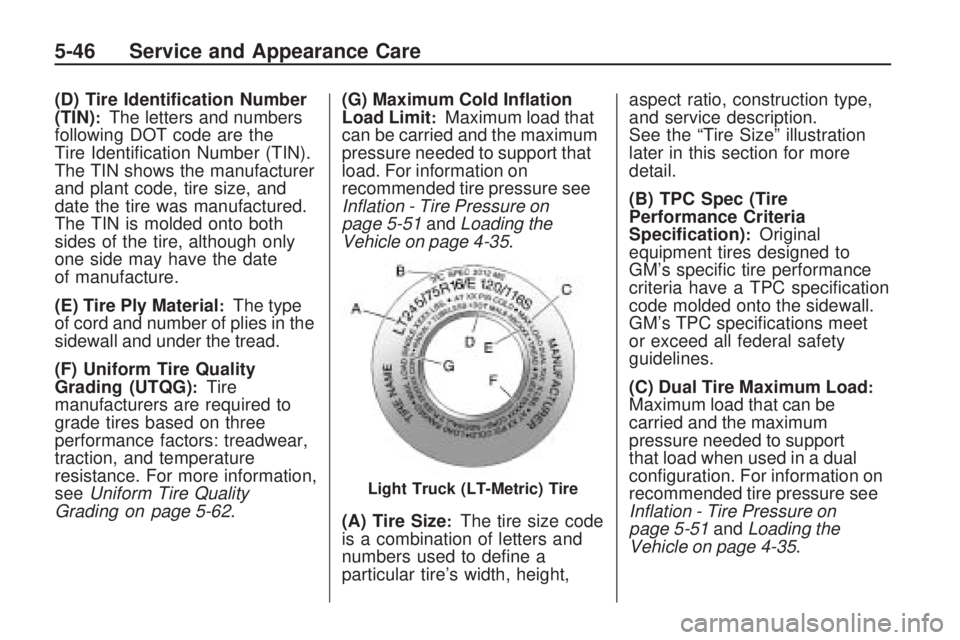
(D) Tire Identi�cation Number
(TIN):The letters and numbers
following DOT code are the
Tire Identi�cation Number (TIN).
The TIN shows the manufacturer
and plant code, tire size, and
date the tire was manufactured.
The TIN is molded onto both
sides of the tire, although only
one side may have the date
of manufacture.
(E) Tire Ply Material
:The type
of cord and number of plies in the
sidewall and under the tread.
(F) Uniform Tire Quality
Grading (UTQG)
:Tire
manufacturers are required to
grade tires based on three
performance factors: treadwear,
traction, and temperature
resistance. For more information,
seeUniform Tire Quality
Grading on page 5-62.(G) Maximum Cold In�ation
Load Limit
:Maximum load that
can be carried and the maximum
pressure needed to support that
load. For information on
recommended tire pressure see
Inflation - Tire Pressure on
page 5-51andLoading the
Vehicle on page 4-35.
(A) Tire Size
:The tire size code
is a combination of letters and
numbers used to de�ne a
particular tire’s width, height,aspect ratio, construction type,
and service description.
See the “Tire Size” illustration
later in this section for more
detail.
(B) TPC Spec (Tire
Performance Criteria
Speci�cation)
:Original
equipment tires designed to
GM’s speci�c tire performance
criteria have a TPC speci�cation
code molded onto the sidewall.
GM’s TPC speci�cations meet
or exceed all federal safety
guidelines.
(C) Dual Tire Maximum Load
:Maximum load that can be
carried and the maximum
pressure needed to support
that load when used in a dual
con�guration. For information on
recommended tire pressure see
Inflation - Tire Pressure on
page 5-51andLoading the
Vehicle on page 4-35.
Light Truck (LT-Metric) Tire
5-46 Service and Appearance Care
Page 283 of 382
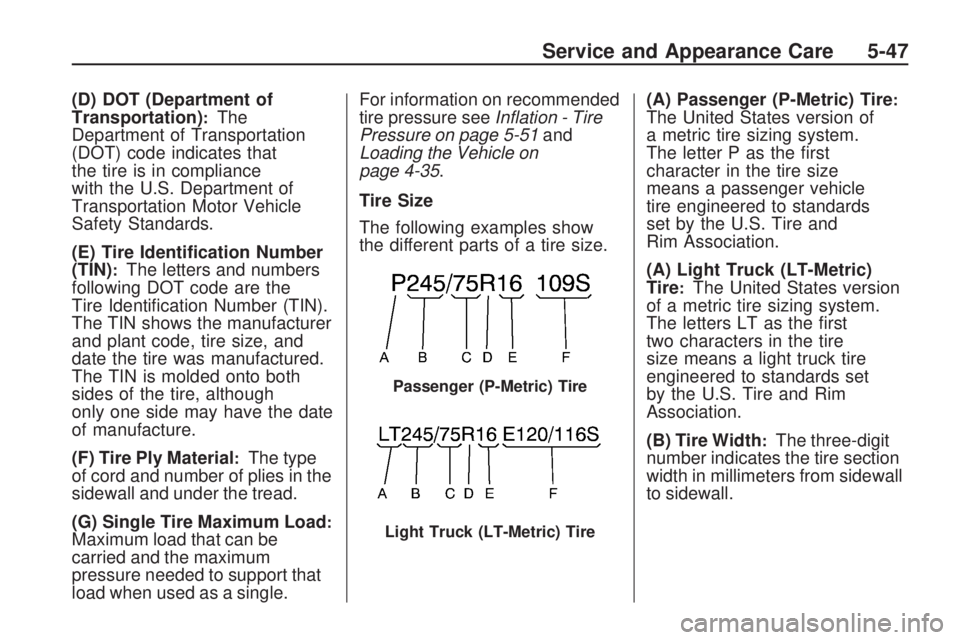
(D) DOT (Department of
Transportation):The
Department of Transportation
(DOT) code indicates that
the tire is in compliance
with the U.S. Department of
Transportation Motor Vehicle
Safety Standards.
(E) Tire Identi�cation Number
(TIN)
:The letters and numbers
following DOT code are the
Tire Identi�cation Number (TIN).
The TIN shows the manufacturer
and plant code, tire size, and
date the tire was manufactured.
The TIN is molded onto both
sides of the tire, although
only one side may have the date
of manufacture.
(F) Tire Ply Material
:The type
of cord and number of plies in the
sidewall and under the tread.
(G) Single Tire Maximum Load
:Maximum load that can be
carried and the maximum
pressure needed to support that
load when used as a single.For information on recommended
tire pressure seeInflation - Tire
Pressure on page 5-51and
Loading the Vehicle on
page 4-35.
Tire Size
The following examples show
the different parts of a tire size.(A) Passenger (P-Metric) Tire
:The United States version of
a metric tire sizing system.
The letter P as the �rst
character in the tire size
means a passenger vehicle
tire engineered to standards
set by the U.S. Tire and
Rim Association.
(A) Light Truck (LT-Metric)
Tire
:The United States version
of a metric tire sizing system.
The letters LT as the �rst
two characters in the tire
size means a light truck tire
engineered to standards set
by the U.S. Tire and Rim
Association.
(B) Tire Width
:The three-digit
number indicates the tire section
width in millimeters from sidewall
to sidewall.
Passenger (P-Metric) Tire
Light Truck (LT-Metric) Tire
Service and Appearance Care 5-47
Page 284 of 382
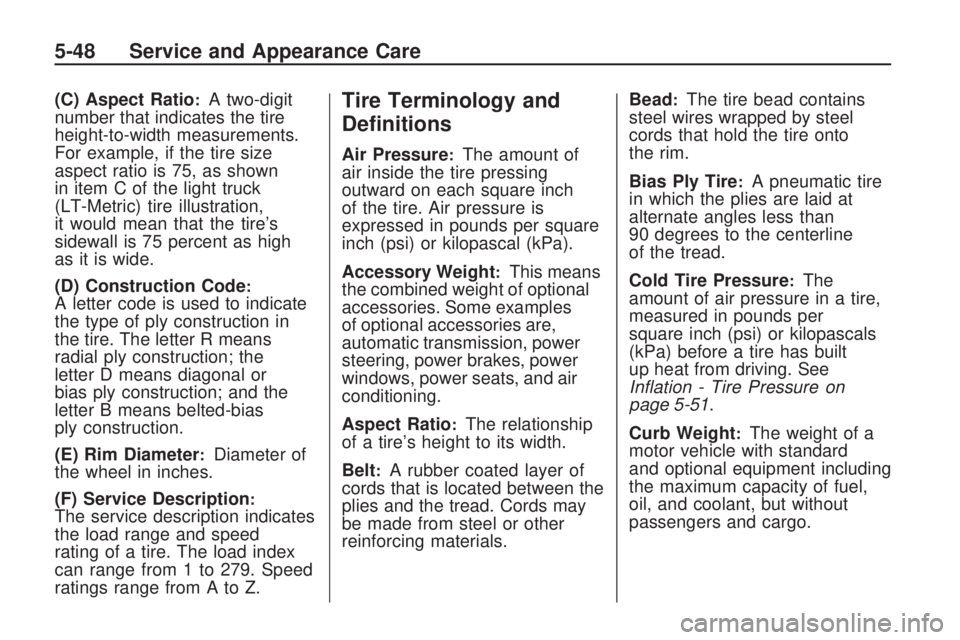
(C) Aspect Ratio:A two-digit
number that indicates the tire
height-to-width measurements.
For example, if the tire size
aspect ratio is 75, as shown
in item C of the light truck
(LT-Metric) tire illustration,
it would mean that the tire’s
sidewall is 75 percent as high
as it is wide.
(D) Construction Code
:A letter code is used to indicate
the type of ply construction in
the tire. The letter R means
radial ply construction; the
letter D means diagonal or
bias ply construction; and the
letter B means belted-bias
ply construction.
(E) Rim Diameter
:Diameter of
the wheel in inches.
(F) Service Description
:The service description indicates
the load range and speed
rating of a tire. The load index
can range from 1 to 279. Speed
ratings range from A to Z.
Tire Terminology and
De�nitions
Air Pressure:The amount of
air inside the tire pressing
outward on each square inch
of the tire. Air pressure is
expressed in pounds per square
inch (psi) or kilopascal (kPa).
Accessory Weight
:This means
the combined weight of optional
accessories. Some examples
of optional accessories are,
automatic transmission, power
steering, power brakes, power
windows, power seats, and air
conditioning.
Aspect Ratio
:The relationship
of a tire’s height to its width.
Belt
:A rubber coated layer of
cords that is located between the
plies and the tread. Cords may
be made from steel or other
reinforcing materials.Bead
:The tire bead contains
steel wires wrapped by steel
cords that hold the tire onto
the rim.
Bias Ply Tire
:A pneumatic tire
in which the plies are laid at
alternate angles less than
90 degrees to the centerline
of the tread.
Cold Tire Pressure
:The
amount of air pressure in a tire,
measured in pounds per
square inch (psi) or kilopascals
(kPa) before a tire has built
up heat from driving. See
Inflation - Tire Pressure on
page 5-51.
Curb Weight
:The weight of a
motor vehicle with standard
and optional equipment including
the maximum capacity of fuel,
oil, and coolant, but without
passengers and cargo.
5-48 Service and Appearance Care
Page 287 of 382
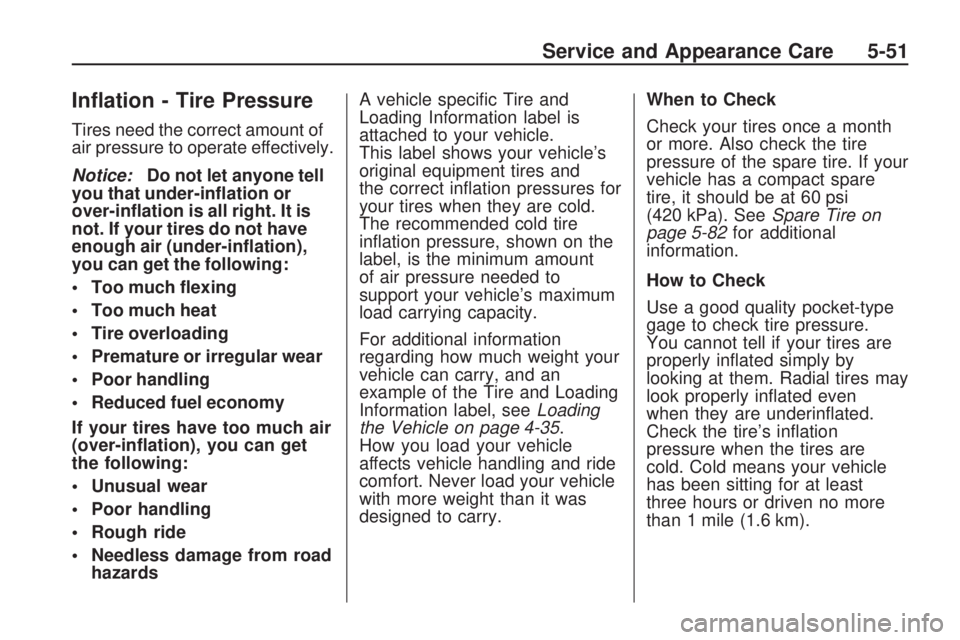
In�ation - Tire Pressure
Tires need the correct amount of
air pressure to operate effectively.
Notice:Do not let anyone tell
you that under-in�ation or
over-in�ation is all right. It is
not. If your tires do not have
enough air (under-in�ation),
you can get the following:
Too much �exing
Too much heat
Tire overloading
Premature or irregular wear
Poor handling
Reduced fuel economy
If your tires have too much air
(over-in�ation), you can get
the following:
Unusual wear
Poor handling
Rough ride
Needless damage from road
hazardsA vehicle speci�c Tire and
Loading Information label is
attached to your vehicle.
This label shows your vehicle’s
original equipment tires and
the correct in�ation pressures for
your tires when they are cold.
The recommended cold tire
in�ation pressure, shown on the
label, is the minimum amount
of air pressure needed to
support your vehicle’s maximum
load carrying capacity.
For additional information
regarding how much weight your
vehicle can carry, and an
example of the Tire and Loading
Information label, seeLoading
the Vehicle on page 4-35.
How you load your vehicle
affects vehicle handling and ride
comfort. Never load your vehicle
with more weight than it was
designed to carry.When to Check
Check your tires once a month
or more. Also check the tire
pressure of the spare tire. If your
vehicle has a compact spare
tire, it should be at 60 psi
(420 kPa). SeeSpare Tire on
page 5-82for additional
information.
How to Check
Use a good quality pocket-type
gage to check tire pressure.
You cannot tell if your tires are
properly in�ated simply by
looking at them. Radial tires may
look properly in�ated even
when they are underin�ated.
Check the tire’s in�ation
pressure when the tires are
cold. Cold means your vehicle
has been sitting for at least
three hours or driven no more
than 1 mile (1.6 km).
Service and Appearance Care 5-51
Page 296 of 382
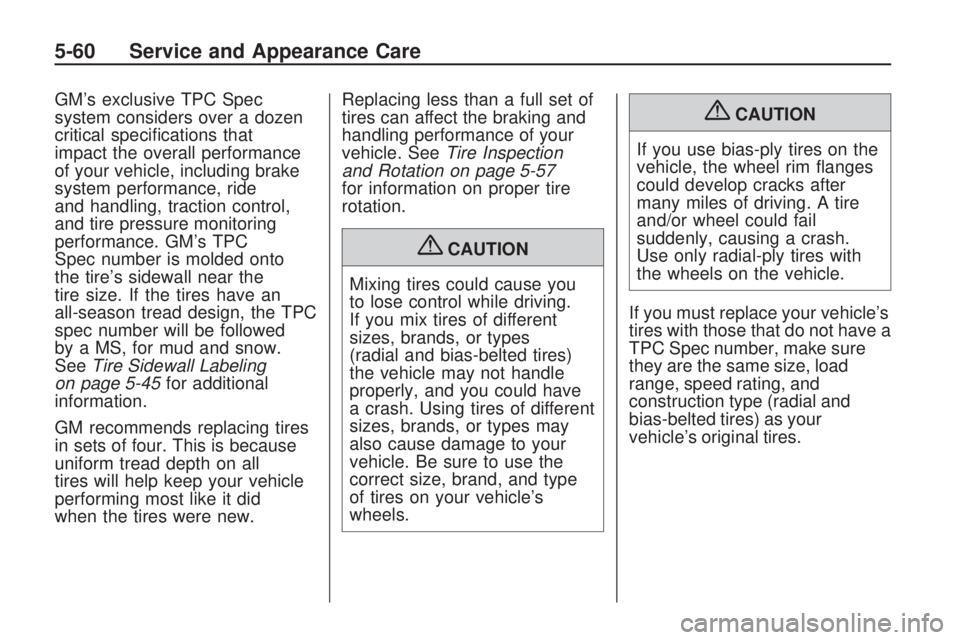
GM’s exclusive TPC Spec
system considers over a dozen
critical speci�cations that
impact the overall performance
of your vehicle, including brake
system performance, ride
and handling, traction control,
and tire pressure monitoring
performance. GM’s TPC
Spec number is molded onto
the tire’s sidewall near the
tire size. If the tires have an
all-season tread design, the TPC
spec number will be followed
by a MS, for mud and snow.
SeeTire Sidewall Labeling
on page 5-45for additional
information.
GM recommends replacing tires
in sets of four. This is because
uniform tread depth on all
tires will help keep your vehicle
performing most like it did
when the tires were new.Replacing less than a full set of
tires can affect the braking and
handling performance of your
vehicle. SeeTire Inspection
and Rotation on page 5-57
for information on proper tire
rotation.
{CAUTION
Mixing tires could cause you
to lose control while driving.
If you mix tires of different
sizes, brands, or types
(radial and bias-belted tires)
the vehicle may not handle
properly, and you could have
a crash. Using tires of different
sizes, brands, or types may
also cause damage to your
vehicle. Be sure to use the
correct size, brand, and type
of tires on your vehicle’s
wheels.
{CAUTION
If you use bias-ply tires on the
vehicle, the wheel rim �anges
could develop cracks after
many miles of driving. A tire
and/or wheel could fail
suddenly, causing a crash.
Use only radial-ply tires with
the wheels on the vehicle.
If you must replace your vehicle’s
tires with those that do not have a
TPC Spec number, make sure
they are the same size, load
range, speed rating, and
construction type (radial and
bias-belted tires) as your
vehicle’s original tires.
5-60 Service and Appearance Care